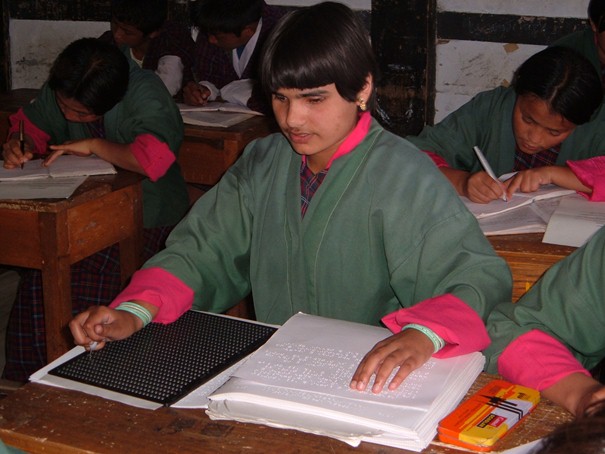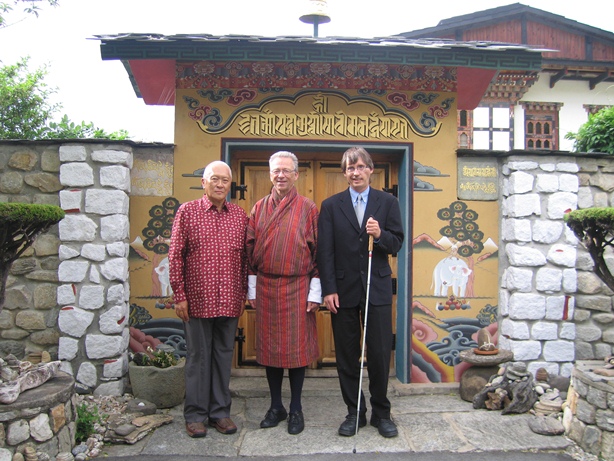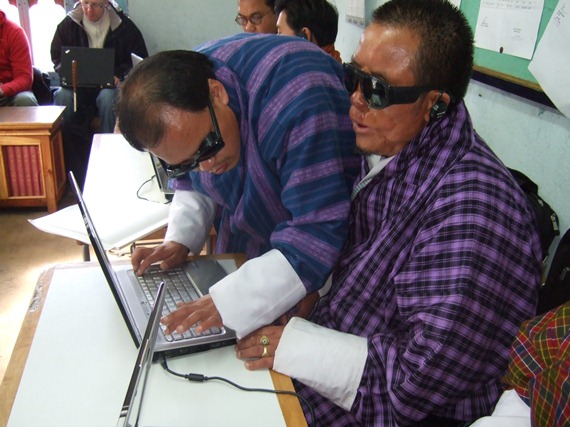1. Introducing the project
In the Spring of 2005, on behalf of the Norwegian Mission, MediaLT initiated a pilot project to investigate the possibilities for a development project to establish a computer literacy programme for visually impaired in Bhutan. An agreement was signed with the Bhutanese authorities in 2007 for a main project that ran for five years from 2007 to 2011. The project was funded by NORAD (Norwegian Agency for Development Cooperation).
Back in 1973 a school for the Blind had been set up in Khaling, Eastern Bhutan. Einar Kippenes, who was then working for the Norwegian and Swedish missions, was a central figure in this work. His Royal Highness Namgyal Wangchuck, then Minister for Trade, Industry and Forests in Bhutan, had taken a personal interest in the school. In 1987 the school was taken over by the national authorities and has since been administered by the Ministry of Education, becoming the National Institute for the Disabled, then the National Institute for the Visually Impaired (NIVI) in 2010.

In this development project a computer literacy programme for visually impaired was established at NIVI. A computer centre was set up there by MediaLT to cater for the needs of visually impaired children at the Institute. A resource group of home teachers developed ICT teaching curricula that were later used to teach Grades one to eight.
During the same period a vocational ICT training course for visually impaired adults was run annually by the resource group.
Kuenga Chhoegyel.
The present story starts with Kuenga Chhoegyel, one of Einar Kippenes' first pupils at the school for the Blind in the 1970s. Kuenga later became a teacher at the Institute.
There had previously existed a great gap in learning between visually impaired pupils using Braille and typewriters at NIVI and sighted pupils in mainstream school. When pupils at NIVI did later transfer to mainstream school their progress was often held back because they were not able to work independently, requiring assistance from staff at NIVI to transcribe printed text to Braille, and Braille back to printed text for their teachers. This was a time consuming process and meant that students were often late in submitting school assignments. Confidentiality was also an issue.
In 2003 Kuenga had attended a computer literacy course for visually impaired in Thailand. Greatly inspired by access to this new technology, he returned home with a vision for all visually impaired children and adults in Bhutan. He wanted to establish a nationwide computer literacy training programme for visually impaired in his country. Kuenga knew that with access to ICT the visually impaired pupils at the Institute would no longer be dependent on Braille transcription, and their new independence would ease the process of integration into mainstream education. They would achieve better results in their studies which would create new opportunities for employment.
“A few years back, computers for the blind in Bhutan was merely a dream. Yet this was something that they hoped and dreamt so much would become a reality: reading newspapers, being able to participate equally, be it in studies or jobs with the help of assistive devices. But now, as we look ahead, we see the future, brighter and with a much better scope for information and technology for the blind.”
- Kuenga Chhoeygel, project initiator.
From a dream to reality.
MediaLT's two-stage strategy.
Kuenga presented his ideas to his former teacher, Einar Kippenes, who still enjoys wide recognition in Bhutan for his earlier work as Principal at the school. There were others who shared Kuenga's vision that computer assistive technology should become available to visually impaired in developing countries. At the same time as Kuenga was putting forward his ideas for introducing computer training at the Institute, Magne Lunde and Morten Tollefsen at MediaLT in Oslo were forming a strategy to transfer ICT skills and computer technology to visually impaired in a developing country. The key principle in their strategy is help to self-help: to assist the disabled in the developing country such that they are able to work on their own initiative to help others in a similar situation. Lunde and Tollefsen thus envisaged a two-stage strategy:
1. The transfer of ICT expertise to a group of national teachers, the resource group.
2. The transfer of ICT technology to a computer centre built up around the resource group in the home country.
On learning of Kuenga's ideas from Einar, Magne and Morten saw that these ideas were very similar to the strategy they wished to implement in a developing country. The project was presented to Nils Magnar Sture at the Norwegian Mission who had previously worked in Bhutan to establish a programme for health care leading to the eradication of leprosy. They were eagerly awaiting an opportunity to return to the country and in 2005 in collaboration with MediaLT a pilot project was initiated to investigate the possibilities for a development project to establish ICT training for visually impaired. The pilot project was supported by NORAD.
As part of the pilot project Magne and Einar visited Bhutan in May 2005. Einar's intimate knowledge of Bhutan, his aptitude in the language and his role as a door opener to all classes in Bhutanese society, from the royal family to the village population, played an important role in the success of this visit.

Meetings with the national education authorities were positive. In addition to meetings at departmental level in Thimphu, meetings were also held with the Principal and relevant staff at NIVI where the computer centre would be located. A letter of intent was signed during this visit by the Director of the Department of School Education and the Norwegian Mission. In the summer of 2005 an application to NORAD was made by the Norwegian Mission for a five year development project.
The main scope of the project was:
to develop the local competence in serving the needs of the visually impaired in Bhutan for managing the computer as a useful tool. The target group is students, adult professionals and the drop outs from the educational stream line.
The main activities in the project were to:
a) Build up the competence of a national resource group which will integrate a nationwide ICT training programme for visually impaired into the education system, setting up ICT curricula and courses for students in primary, secondary and higher secondary school, as well as for adults at college or those either looking for or in employment.
b) Establish a resource centre with the necessary equipment for running courses and for producing audio books according to need.
The application for funds was granted by NORAD at the start of 2006. NORAD would provide 90 percent of the funding, the remaining 10 percent would be funded by the Norwegian Mission. The time limit given for the project was from January 2006 to December 2010 where after the responsibility for ICT training of the visually impaired should be taken over by the Bhutanese education authorities.
Project Organization.
The Ministry of Education, Department of School Education, in the capital Thimphu was the authority representing the Royal Government in Bhutan. Any major changes in the plans and financing were channelled through the Department for its approval or comments. The Norwegian Mission was responsible for covering the financial cost for the project through its application to NORAD via The Norwegian Missions in Development office in Oslo.
The National Institute for the Disabled, now the National Institute for the Visually Impaired (NIVI), was the place where teaching in Bhutan took place. The Department of School Education is responsible for the running of NIVI, including the appointment of staff and covering their salaries. NIVI was responsible for room facilities for setting up the necessary computer equipment. A steering committee was selected from among the NIVI staff to administer the computer centre. NIVI communicated directly with the Norwegian Mission and MediaLT with a copy to the Department of School Education.
MediaLT, on behalf of the Norwegian Mission, was the Norwegian consulting company designated to implement the main tasks of transferring knowledge and experience to the resource group, defining the equipment to be purchased and giving advice about local instalment and utility at the computer centre.
Progress Outline
The Progress Outline was a binding schedule for the progress of the project which might be revised by mutual consent between MediaLT and the Department of Education. Goals and objectives would not be altered. After the initial two year period to transfer competence and to set up the computer centre, three years were assigned for the resource group to further develop the ICT training programme, develop ICT curricula for all classes, start ICT teaching in school and run in-service training courses for adults. After project completion, the Department of School Education would act as the authorizing body and NIVI with its steering committee would be responsible for the implementation of ICT education at NIVI.
Delay in signing the project contract.
After the application for funds was granted by NORAD early in 2006 it seemed as if everything was in order to start in April when the resource group of five teachers would travel to Norway for their introductory training.
Complications arose however over the signing of the project contract by the Bhutanese authorities and the Norwegian Mission. The Bhutanese authorities wanted this development to be incorporated in the state budget requiring the project documentation to be processed not only by the Education ministry, but also by the Finance Ministry and the Foreign Ministry. The signing of the project agreement in Thimphu was delayed.
Back in Norway everything had been prepared for the expected arrival of the resource group at MediaLT in May 2006. Teaching materials had been prepared and computer equipment had been purchased. As the project agreement was not yet signed, the project was brought to a standstill. The project agreement was eventually signed in February 2007 and in the Spring of 2007 the resource group travelled to Norway. The project would now run until the end of 2011.


Tips noen om siden